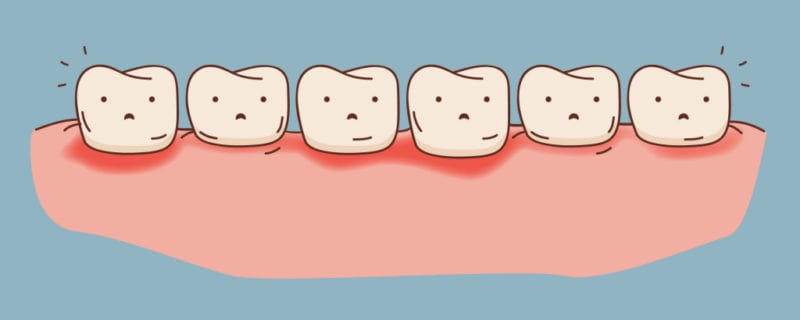
Tooth support tissue diseases can go on for long periods without symptoms or with scant complaints, such as gum bleeding by brushing teeth that people usually don’t pay proper attention to. A superficial examination of the gum may not reveal any particular changes, so only a dentist or dental hygienist can determine whether there is damage to the dental support tissue. Therefore, they should always check that the depth of the gum groove is normal or that the gum pockets have already appeared, their depth and bleeding should be determined by probe. This shows inflammation in the support tissue. X-ray can detect bone loss.
A dentist or dental hygienist will assess the condition of the periodont and start treatment or refer it to a specialist – a periodontologist.
The haemorrhage of the gums by brushing the teeth or biting solid food clearly suggests inflammation of the gums, which can be superficial and fully cusable, or be carried out with loss of the tooth support tissue, the jawbone and connective tissue, which can only be fully detected by the dentist.
Therefore, in case of gum bleeding, a hygienist or dentist should be visited.
It is also one of the signs of gum inflammation, but is more commonly seen in more severe cases of tooth support tissue damage – periodontitis. This sign is more common in smokers and patients with diabetes mellitus.
Inflammation results in the breakdown of connective tissue ligaments and bone, which firmly supports and holds each tooth at a specific spot in the bite. As the disease progresses, tooth mobility increases until the tooth is lost.
Gingivitis is an inflammation that covers only the gum – soft tissue. Abnormal pockets of gums have not yet formed and there is also no loss of the bone supporting the teeth.
Gingivitis is a fully curable disease, but good collaboration between doctor and patient is important. Gingivitis is caused by bacteria found in the abundance of teeth. The hygenist should teach and the patient should learn a suitable dental cleaning technique for him, which is also a staple of gum health.
Periodontitis is already a more complicated disease where inflammation has affected not only the gum but also the rest of the tooth support tissue, which also results in the breakdown of the jawbone, which can run slower or faster depending on the shape of the disease.
Less common, but very destructive, tooth support tissue has the aggressive form of periodontitis already present in predominantly young people, even adolescents. Then bone loss goes very fast.
As periodontitis progresses, pockets of gums deepen, bone loss increases, teeth begin to move, become moving and finally fall out.
It is important to know that periodontitis is a contributing factor in serious diseases such as infarction, stroke and diabetes.
Treatment takes place in several stages depending on the severity of the disease. After active treatment, the maintenance treatment step always follows, which helps to maintain the results obtained.
Gingivitis can usually be successfully treated by a hygienist.
Periodontitis, especially the aggressive forms of periodontitis, are only diagnosed by a hygienist or dentist, but then sent to a specialist, a periodontologist, where complex treatment is underway, which usually also includes surgical treatments to eliminate inflammation in the periodonta and prevent further damage to the support tissue.